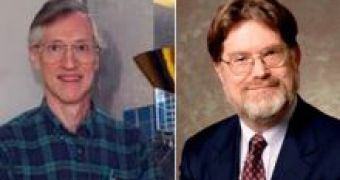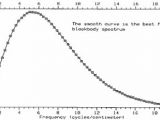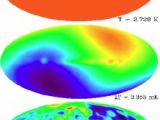The Nobel Prize in physics was won this year by the two astrophysicists who first mapped the afterglow of the Big Bang - the cosmic microwave background radiation penetrating the universe in all directions. They have analyzed the data taken by NASA's satellite called COBE (the Cosmic Background Explorer). The cosmic background radiation was first predicted in 1948 and it was discovered by accident in 1965. However, key detail aspects of this radiation had remained uncertain due to atmospheric disturbances until NASA launched COBE in 1989. The two astrophysicists winning the Nobel Prize this year are John Mather and George Smoot.
John Mather, 60, works at NASA's Goddard Space Flight Center in Greenbelt, Maryland. He and his colleagues measured the precise spectrum of the microwaves revealing that it fits perfectly the theoretical blackbody radiation curve. The departure from this curve was found to be less than 0.001 percent.
This curve describes the correlation between the frequency of light and temperature. For example if one has a box with mirror walls and heats up the box, the material of the mirrors would start to emit light - there would be various photons with different energies (in other words light of various frequencies) flying around inside the box. The light inside such a box would be composed of various numbers of photons with different energies. The blackbody radiation curve tells you how many photons (the brightness) of each energy (light of such and such frequency) are there for a given temperature of the box.
One could measure this curve (brightness as a function of frequency) by making a tiny hole in the box and analyzing the spectrum of the light that comes out. Such a hole is one of the blackest "objects" because any light that happens to enter the box would not be able to get out - that's why this is called the blackbody radiation.
The point is that this curve describes a state of thermodynamic equilibrium inside the box. The fact that the cosmic background radiation fits this curve so perfectly shows that it is also in thermodynamic equilibrium. But how could that be? It comes from all the corners of the universe - how could it have reached equilibrium?
The answer is that in the past the universe was much smaller and the radiation reached equilibrium back then. According to the Nobel committee, this spectrum measurement "verified beyond any reasonable doubt that the cosmic microwave background radiation was created very early in the universe's history. The discovery of temperature ripples gave us the first probe of the exotic physics that occurred within 10-35 seconds after the big bang."
Moreover, the physicists could determine from the curve the temperature of this cosmic radiation. It turned out to be just 2.725 ? 0.002 above absolute zero.
"In the beginning, I was just trying to get the job done and I didn't think about how important it was," Mather says. "But since then, I've realized that it is an essential piece of the history of the universe."
George Smoot, 61, of the Lawrence Berkeley National Laboratory and the University of California, Berkeley, and his colleagues used another instrument to detect slight variations across the sky in the temperature of the background radiation. These tiny variations are considered signs of matter starting to lump together - a process that has lead to the formation of galaxies.
Smoot's team has found that the variations in temperature are much smaller than many physicists have previously thought. As you can imagine, measuring variations less than 0.001 percent is tricky. "It was close," Smoot remembers. But the instruments were precise enough.
What was interesting about the discovery was that the variations turned out to be too small to account for the formation of the galaxies. In other words, the gravitation from usual matter is not enough. "Usual" means that kind of matter we know about (electrons, protons, neutrons and the rest), which is known to interact not only gravitationally but also electromagnetically. As light is an electromagnetic phenomenon it is influenced by the usual matter and thus the usual matter has left its "fingerprint" on the cosmic background radiation.
But Smoot's team found that there had to be more - the gravitation from this usual matter doesn't seem to be sufficient to account for the galaxies. Many assume that there exists another kind of matter, called dark matter, that can interact only gravitationally - it is "dark" precisely because it doesn't have anything to do with light. The three images show that unless one makes the measurements very precise the cosmic background radiation looks totally uniform.
"I chose to work on measuring cosmic background radiation partly because I knew this: Whatever we learned would be fundamental. Regardless of what we found, our observations would tell us about the earthly universe," Smoot wrote in his 1993 book Wrinkles in Time.
Since COBE, NASA has launched another even more precise satellite - the Wilkinson Microwave Anisotropy Probe (WMAP). In 2003 researchers using data from WMAP confirmed the results of Smoot's team, which were published in 1992. Moreover, the European Space Agency plans to launch another even more precise satellite next year. The European satellite is called Planck after Max Planck, the physicist who managed in 1900 to explain why the blackbody curve has that particular form. Plank had shown that the curve can be explained only if one assumes light is emitted in particles - this is how quantum mechanics started.
For a more advanced presentation see: Cosmology and the Cosmic Microwave Background.

 14 DAY TRIAL //
14 DAY TRIAL // 

